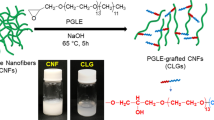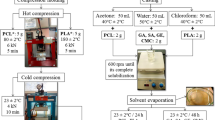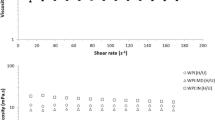Abstract
The characteristics and encapsulating potential of blended polymeric formulations containing gum arabic (GA), maltodextrin (MD), and cellulose nanofibrils (CNF) for microencapsulation of sweet orange essential oil were evaluated in this study. CNF acted as a thickener, increasing emulsion viscosity. The droplet size was affected by the partial replacement of GA in the formulations without CNF; however, the presence of CNF contributed to decreasing the droplet size. CNF-containing formulations had the best encapsulation efficiency. Images obtained by microscopy showed no cracks on the surface of the microparticles. CNF-containing formulations released more essential oil at 25 °C and presented different behaviors when compared to formulations without CNF at 45 °C. The presence of CNF in the wall material formulations was associated with higher encapsulation efficiency of the particles containing essential oil produced by the spray drying.





Similar content being viewed by others
References
Alemdar, A., & Sain, M. (2008). Isolation and characterization of nanofibers from agricultural residues—wheat straw and soy hulls. Bioresource Technology, 99(6), 1664–1671.
Assis, L. M. de, Zavareze, E. da R., Prentice-Hernández, C., & Souza-Soares, L. A. De. (2012). Characteristics of nanoparticles and their potential applications in foods. Brazilian Journal of Food Technology, 15(2), 99–109.
ASSOCIATION OF OFFICIAL ANALYTICAL CHEMISTS—AOAC. (2007). Official methods of analysis. (485, Ed.) (17th ed.). Maryland: AOAC.
Bakkali, F., Averbeck, S., Averbeck, D., & Idaomar, M. (2008). Biological effects of essential oils—a review. Food and Chemical Toxicology, 46(2), 446–475.
Baranauskiené, R., Venskutonis, P. R., Dewettinck, K., & Verhe, R. (2006). Properties oforegano (Origanum vulgare L.), citronella (Cymbopogon nardus G.) and marjoram (Majorana hortensis L.) flavors encapsulated into milk protein-based matrices. Food Research International, 39(4), 413–425.
Buffo, R. A., Probst, K., Zehentbauer, G., Luo, Z., & Reineccius, G. A. (2002). Effects of agglomeration on the properties of spray-dried encapsulated flavours. Flavour and Fragrance Journal, 17(4), 292–299.
Burgess, D. J., Sahin, N., & Sahin, O. N. (1998). Influence of protein emulsifier interfacial properties on oil-in-water emulsion stability. Pharmaceutical Development and Technology, 3(1), 21–29.
Cai, Y. Z. Z., & Corke, H. (2000). Production and properties of spray-dried amaranthus betacyanin pigments. Journal of Food Science, 65(7), 1248–1252.
Calo, J. R., Crandall, P. G., O’Bryan, C. A., & Ricke, S. C. (2015). Essential oils as antimicrobials in food systems - A review. Food Control, 54, 111–119.
Cano-Chauca, M., Stringheta, P. C. C., Ramos, A. M. M., & Cal-Vidal, J. (2005). Effect of the carriers on the microstructure of mango powder obtained by spray drying and its functional characterization. Innovative Food Science & Emerging Technologies, 6(4), 420–428.
Carmona, P. A. O., Tonon, R. V., da Cunha, R. L., & Hubinger, M. D. (2013). Influence of emulsion properties on the microencapsulation of orange essential oil by spray drying. Journal of Colloid Science and Biotechnology, 2(2), 130–139.
Carneiro, H. C. F. F., Tonon, R. V., Grosso, C. R. F. F., & Hubinger, M. D. M. D. (2013). Encapsulation efficiency and oxidative stability of flaxseed oil microencapsulated by spray drying using different combinations of wall materials. Journal of Food Engineering, 115(4), 443–451.
Chevalier, Y., & Bolzinger, M. A. (2013). Emulsions stabilized with solid nanoparticles: pickering emulsions. Colloids and Surfaces A: Physicochemical and Engineering Aspects, 439, 23–34.
de Kort, D., Veen, S., Van As, H., Bonn, D., Velikov, K., & Van Duynhoven, J. (2016). Yielding and flow of cellulose microfibril dispersions in the presence of a charged polymer. Soft Matter, 12(21), 4739–4744.
Do, T. K. T., Hadji-Minaglou, F., Antoniotti, S., & Fernandez, X. (2015). Authenticity of essential oils. TrAC Trends in Analytical Chemistry, 66, 146–157.
Dordevic, V., Balanč, B., Belščak-Cvitanović, A., Lević, S., Trifković, K., Kalušević, A., et al. (2015). Trends in encapsulation technologies for delivery of food bioactive compounds. Food Engineering Reviews, 7(4), 452–490.
Dufresne, A. (2013). Nanocellulose: a new ageless bionanomaterial. Materials Today, 16(6), 220–227.
Fernandes, R. V. B., Borges, S. V., & Botrel, D. A. (2014). Gum arabic/starch/maltodextrin/inulin as wall materials on the microencapsulation of rosemary essential oil. Carbohydrate Polymers, 101(1), 524–532.
Forny, L., Marabi, A., & Palzer, S. (2011). Wetting, disintegration and dissolution of agglomerated water soluble powders. Powder Technology, 206(1–2), 72–78.
Frascareli, E. C., Silva, V. M., Tonon, R. V., & Hubinger, M. D. (2012). Effect of process conditions on the microencapsulation of coffee oil by spray drying. Food and Bioproducts Processing, 90(3), 413–424.
Fuchs, M., Turchiuli, C., Bohin, M., Cuvelier, M. E. E., Ordonnaud, C., Peyrat-Maillard, M. N. N., et al. (2006). Encapsulation of oil in powder using spray drying and fluidised bed agglomeration. Journal of Food Engineering, 75(1), 27–35.
Garcia, L. C., Tonon, R. V., & Hubinger, M. D. (2012). Effect of homogenization pressure and oil load on the emulsion properties and the oil retention of microencapsulated basil essential oil (Ocimum basilicum L.) Drying Technology, 30(13), 1413–1421.
Gardner, D. J., Oporto, G. S., Mills, R., & Samir, M. A. S. A. (2008). Adhesion and surface issues in cellulose and nanocellulose. Journal of Adhesion Science and Technology, 22(5–6), 545–567.
Gharsallaoui, A., Roudaut, G., Chambin, O., Voilley, A., & Saurel, R. (2007). Applications of spray-drying in microencapsulation of food ingredients: an overview. Food Research International, 40(9), 1107–1121.
Habibi, Y., Mahrouz, M., & Vignon, M. R. (2009). Microfibrillated cellulose from the peel of prickly pear fruits. Food Chemistry, 115(2), 423–429.
Jafari, S. M., Assadpoor, E. M., He, Y., & Bhandari, B. (2008). Encapsulation efficiency of food flavours and oils during spray drying. Drying Technology, 26(7), 816–835.
Jowkarderis, L., & Van De Ven, T. G. M. (2015). Rheology of semi-dilute suspensions of carboxylated cellulose nanofibrils. Carbohydrate Polymers, 123, 416–423.
Lavoine, N., Desloges, I., Dufresne, A., & Bras, J. (2012). Microfibrillated cellulose—its barrier properties and applications in cellulosic materials: a review. Carbohydrate Polymers, 90(2), 735–764.
Lavoratti, A., Scienza, L. C., & Zattera, A. J. (2016). Dynamic-mechanical and thermomechanical properties of cellulose nanofiber/polyester resin composites. Carbohydrate Polymers, 136, 955–963.
Löbmann, K., & Svagan, A. J. (2017). Cellulose nano fibers as excipient for the delivery of poorly soluble drugs. International Journal of Pharmaceutics, 533(1), 285–297.
Lu, W.-C., Chiang, B.-H., Huang, D.-W., & Li, P.-H. (2014). Skin permeation of d-limonene-based nanoemulsions as a transdermal carrier prepared by ultrasonic emulsification. Ultrasonics Sonochemistry, 21(2), 826–832.
Madene, A., Jacquot, M., Scher, J. J. J., & Desobry, S. S. S. (2006). Flavour encapsulation and controlled release—a review. International Journal of Food Science and Technology, 41(1), 1–21.
Maisuthisakul, P., & Gordon, M. H. (2012). Influence of polysaccharides and storage during processing on the properties of mango seed kernel extract (microencapsulation). Food Chemistry, 134(3), 1453–1460.
Marto, A. F., Dumont, P. J. J., Belgacem, M. N., & Putaux, J. L. (2016). Micro-mechanics of electrostatically stabilized suspensions of cellulose nanofibrils under steady state shear flow. Royal Society Chemistry, 12, 1721–1735.
Moon, R. J., Martini, A., Nairn, J., Simonsen, J., & Youngblood, J. (2011). Cellulose nanomaterials review: structure, properties and nanocomposites. Chemical Society Reviews, 40(7), 3941–3994.
Perdana, J., Fox, M. B., Siwei, C., Boom, R. M., & Schutyser, M. A. I. (2014). Interactions between formulation and spray drying conditions related to survival of Lactobacillus plantarum WCFS1. Food Research International, 56, 9–17.
Phisut, N. (2012). Spray drying technique of fruit juice powder: some factors influencing the properties of product. International Food Research Journal, 19(4), 1297–1306.
Rajabi, H., Ghorbani, M., Jafari, S. M., Sadeghi Mahoonak, A., & Rajabzadeh, G. (2015). Retention of saffron bioactive components by spray drying encapsulation using maltodextrin, gum Arabic and gelatin as wall materials. Food Hydrocolloids, 51, 327–337.
Rascón, M. P., Beristain, C. I., García, H. S., Salgado, M. A., Rascón, M. P., Beristain, C. I., et al. (2011). Carotenoid retention and storage stability of spray-dried encapsulated paprika oleoresin using gum Arabic and soy protein isolate as wall materials. LWT - Food Science and Technology, 44(2), 549–557.
Raut, J. S., & Karuppayil, S. M. (2014). A status review on the medicinal properties of essential oils. Industrial Crops and Products, 62, 250–264.
Rebello, F. D. F. P. (2009). Microencapsulação de ingredientes alimentícios. Revista Agrogeoambiental, 1(3), 134–144.
Silva, E. K., Zabot, G. L., Cazarin, C. B. B., Maróstica, M. R., & Meireles, M. A. A. (2016). Biopolymer-prebiotic carbohydrate blends and their effects on the retention of bioactive compounds and maintenance of antioxidant activity. Carbohydrate Polymers, 144, 149–158.
Soottitantawat, A., Takayama, K., Okamura, K., Muranaka, D., Yoshii, H., Furuta, T., Ohkawarab, M., & Linko, P. (2005). Microencapsulation of l-menthol by spray drying and its release characteristics. Innovative Food Science & Emerging Technologies, 6(2), 163–170.
Tanaka, R., Saito, T., Hänninen, T., Ono, Y., Hakalahti, M., Tammelin, T., & Isogai, A. (2016). Viscoelastic properties of core–shell-structured, hemicellulose-rich nanofibrillated cellulose in dispersion and wet-film states. Biomacromolecules, 17(6), 2104–2111.
Uekane, T. M., Costa, A. C. P., Pierucci, A. P. T. R., da Rocha-Leão, M. H. M., & Rezende, C. M. (2016). Sulfur aroma compounds in gum Arabic/maltodextrin microparticles. LWT - Food Science and Technology, 70, 342–348.
Wu, T.-M., & Wu, C.-Y. (2006). Biodegradable poly(lactic acid)/chitosan-modified montmorillonite nanocomposites: preparation and characterization. Polymer Degradation and Stability, 91(9), 2198–2204.
Wu, Y., Zou, L., Mao, J., Huang, J., & Liu, S. (2014). Stability and encapsulation efficiency of sulforaphane microencapsulated by spray drying. Carbohydrate Polymers, 102, 497–503.
Yoshii, H., Soottitantawat, A., Liu, X.-D. D., Atarashi, T., Furuta, T., Aishima, S., et al. (2001). Flavor release from spray-dried maltodextrin/gum arabic or soy matrices as a function of storage relative humidity. Innovative Food Science & Emerging Technologies, 2(1), 55–61.
Yousefi, S., Emam-Djomeh, Z., & Mousavi, S. M. (2011). Effect of carrier type and spray drying on the physicochemical properties of powdered and reconstituted pomegranate juice (Punica Granatum L.) Journal of Food Science and Technology, 48(6), 677–684.
Acknowledgements
The authors thank FAPEMIG (Minas Gerais State Foundation for Research Development, Brazil) (CAG-PPM-00318-11) and CNPq (National Council for Scientific and Technological Development, Brazil) (grant number 448530/2014-7) for the financial support; the Laboratory of Electronic Microscopy and Ultra-structural Analysis of the Federal University of Lavras, Brazil, and the Electronic Microscopy Center, Sector of Biological Sciences, Federal University of Paraná, Brazil, for support on the microscopic analysis; and the Laboratory of Wood and Pulp Chemistry and Paper of the Federal University of Paraná, Brazil, for providing the cellulose nanofibrils.
Author information
Authors and Affiliations
Corresponding author
Rights and permissions
About this article
Cite this article
de Souza, H.J.B., Fernandes, R.V.d., Borges, S.V. et al. Utility of Blended Polymeric Formulations Containing Cellulose Nanofibrils for Encapsulation and Controlled Release of Sweet Orange Essential Oil. Food Bioprocess Technol 11, 1188–1198 (2018). https://doi.org/10.1007/s11947-018-2082-9
Received:
Accepted:
Published:
Issue Date:
DOI: https://doi.org/10.1007/s11947-018-2082-9




